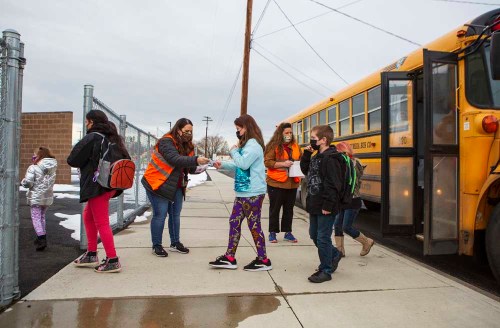Schools spent most of federal aid on virtual learning
Published 9:00 am Thursday, March 4, 2021

- Staff greet students as they get off the bus at Washington Elementary School in Pendleton on the first day of in-person instruction on Feb. 22, 2021.
SALEM — Since the start of the pandemic, the federal government has earmarked nearly $620 million in emergency funds for Oregon schools.
About $121 million that has arrived in Oregon so far has helped schools across the state purchase laptops, internet hotspots and program licenses to set up the virtual learning programs that have dominated the Oregon classroom experience over the last year.
Trending
But a second round of federal funds is expected to deliver another $499 million to school districts by the end of the month, the state’s share of a $900 billion relief bill passed in December 2020.
And the bulk of that money should go toward reopening schools.
What that looks like will differ from district to district.
Some may need to upgrade ventilation systems or purchase air filters and fans. Others might opt to renovate classrooms to provide more space for students as the pandemic wears on.
Mike Wiltfong, the Oregon Department of Education’s director of school finance and facilities, said schools that are already open for in-person instruction provide a glimpse at how districts will need to spend federal aid.
“We’re already seeing where schools are struggling — some students sit in the hallway,” he told The Oregonian.
Trending
Wiltfong is concerned that Oregon schools will start burning through their federal aid allocations as districts begin rolling out their in-person offerings. In December 2020, about 50,000 of Oregon’s 580,000 public K-12 students were getting some sort of in-person instruction.
As of last week, that number was just over 136,000.
In states where governors ordered schools to reopen, such as Iowa, Texas and Arkansas, districts went through large chunks of their share of federal aid by the end of November 2020, according to the most recent data from the U.S. Department of Education.
By December 2020, Texas schools spent 42% of their allocation in federal aid. In Iowa, it was 92%.
Wiltfong said that once Oregon schools fully reopen for in-person learning, it’ll cost about $500 per student to educate them safely every year, or about $290 million.
Even though the White House has pledged to inoculate every adult in the country by the end of May, it doesn’t mean COVID-19 goes away. And that means schools will still need a steady supply of hand sanitizer and cleaning materials.
Some may even have to take on construction projects to increase ventilation or expand classrooms.
“What is going to be the appropriate spacing for students in the future?” Wiltfong said. “What happens if we have a run-in with another variant of the virus?”
Wiltfong said districts are wary of tapping into too much of the federal pot at this point in the pandemic. Even though Oregon’s economy fared better than expected over the last year and schools avoided much-feared cuts in funding, that sort of fortune isn’t guaranteed in the future.
And such unknowns are part of the reason districts have until September of 2022 to apply for reimbursements for federal coronavirus aid.
“They’re proceeding in the best manner they can based on local decisions,” Wiltfong said.









